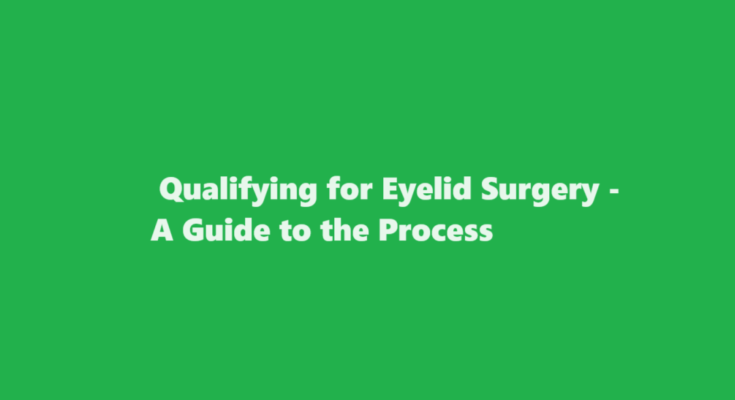Introduction
Eyelid surgery, also known as blepharoplasty, is a cosmetic procedure aimed at enhancing the appearance of the eyelids. This surgery can address issues such as sagging skin, puffiness, and wrinkles around the eyes, helping patients achieve a more youthful and refreshed look. However, not everyone is a suitable candidate for eyelid surgery. To qualify for this procedure, several factors must be considered, including your physical health, expectations, and the expertise of your chosen surgeon. In this article, we will explore the essential criteria and steps to qualify for eyelid surgery.
Consultation with a Board-Certified Plastic Surgeon
The first step in determining if you qualify for eyelid surgery is to schedule a consultation with a board-certified plastic surgeon. During this consultation, your surgeon will evaluate your medical history, discuss your goals and expectations, and examine your eyelids to determine if you are a suitable candidate. This initial meeting is crucial, as it helps both you and your surgeon make informed decisions about your candidacy for the procedure.
Good Physical Health
One of the primary qualifications for eyelid surgery is good physical health. Your surgeon will assess your overall health to ensure that you can undergo the procedure safely. If you have any underlying medical conditions, such as uncontrolled diabetes or high blood pressure, it may affect your eligibility. Additionally, a history of eye diseases like glaucoma or dry eyes may need to be addressed before proceeding with the surgery.
Realistic Expectations
Before undergoing eyelid surgery, it’s vital to have realistic expectations about the outcomes. This procedure can enhance the appearance of your eyelids, but it won’t completely change your face or stop the natural ageing process. Your surgeon will discuss what can be achieved and help you set reasonable expectations to avoid disappointment.
Specific Concerns to Address
You may qualify for eyelid surgery if you have specific concerns related to your eyelids. These concerns may include
a. Excess skin on the upper eyelids: If sagging skin on your upper eyelids obstructs your vision or affects your appearance, eyelid surgery can be a suitable solution.
b. Puffy bags under the eyes: Lower eyelid surgery can address puffy bags under the eyes caused by fat deposits, making you look more rested and youthful.
c. Fine lines and wrinkles: Eyelid surgery can help reduce the appearance of wrinkles around the eyes, enhancing your overall facial appearance.
d. Drooping eyelids: If your eyelids droop significantly, it can impact your vision and may qualify you for the procedure.
Age Considerations
While there is no specific age limit for eyelid surgery, candidates are typically in their 30s and older. Younger patients may qualify if they have inherited conditions or early signs of aging. It’s essential to consult with a plastic surgeon who can assess your unique circumstances.
Emotional and Mental Readiness
Eyelid surgery is a significant decision, and candidates should be emotionally and mentally prepared for the procedure. Ensure that you fully understand the potential risks, benefits, and recovery process. It’s also important to have a strong support system in place for the post-operative period.
Non-Smoking Status
Smoking can have adverse effects on the healing process and increase the risk of complications. Most surgeons recommend that candidates for eyelid surgery be non-smokers or commit to quitting at least several weeks before the procedure.
Realistic Financial Planning
Eyelid surgery is an elective procedure, which means it is not covered by insurance. Candidates must have a realistic financial plan in place to cover the costs, which can vary depending on the extent of the surgery and the location of the practice. Financing options may be available, so discuss this with your surgeon during the consultation.
Choosing the Right Surgeon
Selecting a qualified and experienced surgeon is critical to the success of your eyelid surgery. Research potential surgeons, review their credentials, and ask for before-and-after photos of previous patients. Ensure that your chosen surgeon is board-certified and has a proven track record in performing eyelid surgery.
Recovery and Aftercare
Candidates must be prepared to follow post-operative care instructions diligently. The recovery process for eyelid surgery typically includes some bruising and swelling, which can last for a few weeks. It’s crucial to take time off work and other responsibilities, and follow all post-operative instructions to facilitate a smooth recovery.
FREQUENTLY ASKED QUESTIONS
What is the criteria for upper eyelid surgery?
These include (but are not limited to): Significant interference with vision or superior or lateral visual field, (e.g., difficulty seeing objects approaching from the periphery); Difficulty reading due to superior visual field loss; or, Looking through the eyelashes or seeing the upper eyelid skin.
Who is not a good candidate for eyelid surgery?
If you have any pre-existing medical conditions, let the surgeon know during the consultation. Persons with dry eye, diabetes, and glaucoma may not be suitable candidates for eyelid surgery.
Conclusion
Qualifying for eyelid surgery is a thorough process that involves a combination of physical health, emotional readiness, realistic expectations, and the expertise of a board-certified plastic surgeon. To determine your eligibility, consult with a surgeon who can assess your unique situation and guide you through the decision-making process. If you meet the necessary criteria and are well-prepared for the procedure, eyelid surgery can be a highly rewarding experience, helping you achieve a more youthful and refreshed appearance.
Read Also : A Comprehensive Guide to Buying Anesthesia Machines



